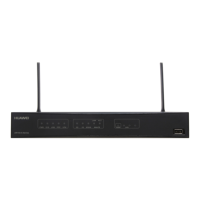Spanning
Tree
Protocol
Characteristics Applicable
Environment
Precautions
RSTP
l Ensures a loop-free
tree topology that helps
prevent broadcast
storms and allows for
redundant links
between switches.
l Provides a feedback
mechanism to confirm
topology convergence,
implementing rapid
convergence.
See MSTP
Configuration.
MSTP
l Ensures a loop-free
tree topology that helps
prevent broadcast
storms and allows for
redundant links
between switches in an
MSTP region.
l Provides a feedback
mechanism to confirm
topology convergence,
implementing rapid
convergence.
l Implements load
balancing among
VLANs. Traffic in
different VLANs is
transmitted along
different paths.
User or service-specific
load balancing is
required. Traffic for
different VLANs is
forwarded through
different spanning
trees, which are
independent of each
other.
7.2 STP/RSTP Features Supported by the AR3200
Before configuring STP/RSTP, familiarize yourself with basic STP/RSTP functions, topology
convergence, STP/RSTP protection, and STP/RSTP interoperability between Huawei devices
and non-Huawei devices.
STP/RSTP is used to block redundant links on Layer 2 networks and trim a network into a loop-
free tree topology.
STP/RSTP also supports the following features to meet the requirements of special applications
and extended functions:
l Provides a feedback mechanism to confirm topology convergence, implementing rapid
convergence.
l RSTP provides the protection functions listed in Table 7-4.
Huawei AR3200 Series Enterprise Routers
Configuration Guide - LAN 7 STP/RSTP Configuration
Issue 02 (2012-03-30) Huawei Proprietary and Confidential
Copyright © Huawei Technologies Co., Ltd.
186

